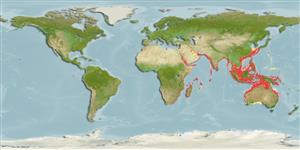Environment: milieu / climate zone / depth range / distribution range
ນິເວດວິທະຍາ
ສັດທະເລ; ນ້ຳກ່ອຍ ກ່ຽວກັນຫີນ; ປາທີ່ມີການເຄື່ອນຍ້າຍໃນສະເພາະມາະຫາສະມຸດ (Ref. 51243); ລະດັບຄວາມເລິກ 20 - 200 m (Ref. 36128). Subtropical; 32°N - 35°S, 18°E - 157°E
Indo-West Pacific: Red Sea and East Africa to the Philippines, north to southern Japan and Korea, south to northern Australia. Introduced into the eastern Mediterranean Sea.
Length at first maturity / ຂະໜາດ / ນ້ຳໜັກ / Age
Maturity: Lm 45.7 range ? - ? cm
Max length : 100.0 cm TL ຕົວຜູ້/ບໍ່ມີເພດ; (Ref. 7050); common length : 60.0 cm TL ຕົວຜູ້/ບໍ່ມີເພດ; (Ref. 3476); ນ້ຳໜັກສູງສຸດທີ່ເຄຍຈັດພີມມາ: 3.5 kg (Ref. 40637)
ຄີ (ໜາມ)ແຂງຢູ່ຫຼັງປາ (ທັງໝົດ) : 9 - 10; ຄີຫຼັງຂອງປາ (ຄີອ່ອນ) (ທັງໝົດ) : 13; ຄີ(ໜາມ) ແຂງຢູ່ຄີກົ້ນປາ
ກຸ່ມປາກະດູກແຂງ
ຄວາມຖີ່ຂອງກຸ່ມຖ່າຍທອດພັນ
ປາທີ່ມີການເຄື່ອນຍ້າຍຈາກທະເລໄປຫານ້ຳຈືດ ແລະນ້ຳຈືດຫາທະເລ
ປາທີ່ມີການເຄື່ອນຍ້າຍຈາກທະເລແລະໄປໄຂ່ຢູ່ນ້ຳຈືດ
ຄີກົ້ນຂອງປາ
ສັດທີ່ມີກະດູກສັນຫັຼງ
ການຖ່າຍທອດທາງກຳມະພັນຈາກພໍ່ແມ່ຫາລູກ: 0; ຄີກົ້ນຂອງປາ: 13. Brownish or grayish above, whitish below; caudal fin 2-3 horizontal black stripes (Ref. 4315). Head strongly depressed. Preopercular spines 2, lower usually longest. Vomerine teeth in a single transverse band. Dorsal fin I,VII,I, I,I,VII,I or I,VIII, 13. Anteriormost lateral line scale usually with a small spine or ridge. Diagonal scale rows slanting backward above lateral line 83-107. Iris lappet a single elongated lobe. Identified by the distinctive color pattern on the caudal fin: centrally yellow and black stripes on upper and lower margins (Ref. 48635).
Found on sandy and muddy bottoms of coastal waters (Ref. 5213, 48635). Frequently in estuaries, juveniles have been taken in freshwater. Taken by handlining and seining in shallow waters and by trawling at depths to 30 m, usually less (Ref. 9790). A good food fish (Ref. 4315) that is marketed fresh (Ref. 5284). Commercially cultured in Japan. Used in Chinese medicine (Ref. 12166).
Also Ref. 103751.
Bauchot, M.-L., 1987. Poissons osseux. p. 891-1421. In W. Fischer, M.L. Bauchot and M. Schneider (eds.) Fiches FAO d'identification pour les besoins de la pêche. (rev. 1). Méditerranée et mer Noire. Zone de pêche 37. Vol. II. Commission des Communautés Européennes and FAO, Rome. (Ref. 3397)
IUCN Red List Status (Ref. 130435: Version 2024-1)
Threat to humans
Harmless
Human uses
ການປະມົງ: ເປັນສີນຄ້າ; ການລ້ຽງສັດນ້ຳ: ເປັນສີນຄ້າ; ຊະນິດປາທີ່ຖືກນຳໃຊ້ເຂົ້າໃນການຫາເພື່ອເປັນເກມກິລາ: ແມ່ນ
ເຄື່ອງມື
Special reports
Download XML
ແຫຼ່ງອີນເຕີເນັດ
Estimates based on models
Preferred temperature (Ref.
123201): 21.7 - 28.3, mean 26.5 °C (based on 979 cells).
Phylogenetic diversity index (Ref.
82804): PD
50 = 0.5000 [Uniqueness, from 0.5 = low to 2.0 = high].
Bayesian length-weight: a=0.00447 (0.00363 - 0.00550), b=3.09 (3.03 - 3.15), in cm total length, based on LWR estimates for this species (Ref.
93245).
ຊັ້ນເຂດຮ້ອນ (Ref.
69278): 3.6 ±0.6 se; based on diet studies.
ຄວາມຢືດຢຸ່ນ (Ref.
120179): ຂະໜາດກາງ, ປະຊາກອນຕຳ່ສຸດທີ່ໃຊ້ເວລາສອງເທົ່າ 1.4 - 4.4 ປີ (tmax=7).
Prior r = 0.64, 95% CL = 0.42 - 0.96, Based on 1 data-limited stock assessment.
Fishing Vulnerability (Ref.
59153): Moderate vulnerability (37 of 100).
Climate Vulnerability (Ref.
125649): Very high vulnerability (79 of 100).
Nutrients (Ref.
124155): Calcium = 43.2 [3.4, 132.2] mg/100g; Iron = 1.21 [0.32, 3.24] mg/100g; Protein = 18.8 [16.5, 21.1] %; Omega3 = 0.211 [0.090, 0.614] g/100g; Selenium = 48.1 [16.2, 149.5] μg/100g; VitaminA = 28.9 [8.7, 99.7] μg/100g; Zinc = 0.763 [0.357, 1.425] mg/100g (wet weight); based on
nutrient studies.
